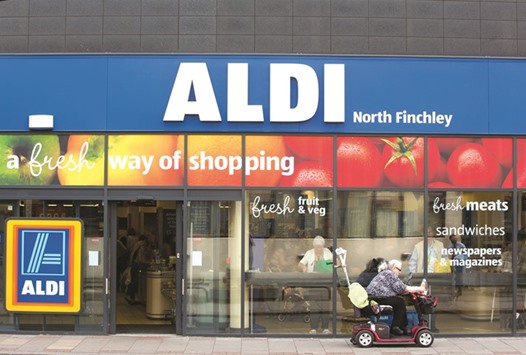Out with the cardboard boxes, rough forklift crates and no-frills warehouse look — in with cozy wood panelling, natural light and chilled fruit smoothies at the breakfast bar.
Aldi, Germany’s original discount supermarket chain, is getting a major facelift — spelling the end of an era, at least in design terms, for the traditional first-stop shop of the thrifty German housewife.
Rising competition has pushed the retail giant to move away from its “hard discount” industrial look that promised savings toward a luxurious customer experience.
Aldi Sued — the division of the brand that runs stores in Germany’s south and west — last week showed off its “Future Store” concept at Unterhaching near the southern city of Munich.
The new-look stores, set to be adopted in its nearly 1,900 locations in the next three years, will have products neatly stacked in shelves, rather than piled up or scattered on tables.
And a cafe area will offer fair trade coffee, fresh smoothies and other chilled beverages. There will be benches for senior citizens and customer toilets with baby changing tables.
Aldi, an empire built on shaving off unnecessary costs, declined to say how much its renovations will cost.
Jeannette Thull, head of central purchasing, said it wasn’t pushed to update its image but was responding to changing consumer tastes.
“We have a healthy confidence in ourselves,” she said, promising that while the new look should draw new customers, the prices will stay low.
Retail market expert Wolfgang Adlwarth of the GfK institute said the move spells “clearly a change in philosophy”.
He saw both Aldi and rival Lidl moving further away from the “hard discount” segment through a range of changes in recent years.
Both have introduced, for example, organic and regional produce on their food and vegetables shelves and fresh bread baked in-store, he said.
Such innovations have come in response to sliding market share for the still-dominant brands — from a combined 43.7% in 2013, to 42.3% in 2015, according to GfK.
Germans are getting out of the habit of buying staple products in bulk at discounters and treats at higher-end supermarkets and speciality stores, he said.
The challenge, therefore, was to capture and retain customers at a “single point of purchase”.
In their markets abroad, both Aldi and Lidl have also been rethinking their stores to “highlight the quality and price and no longer speak only about low prices,” said Frederic Valette of market research firm Kantar Worldpanel.
In a sign the strategy is working, Aldi has almost doubled its market share in Britain over three years to 6% in early 2016.
Lidl has grown to gain a 5.2% market share in France, up from 4.6% in 2013, according to figures compiled by Kantar.
The changes do not spell the end of the discounter, which gains “huge cost savings” from keeping a slim range of products, said Valette.
Aldi’s product range of about 1,200 per store is still far below the over 10,000 offered by a typical supermarket or the more than 35,000 found in a so-called hypermarket.
The huge investments now in rebranding spell initial costs but should “generate long-term economic returns,” he added.
Already Aldi and the owners of Lidl — the Schwarz Group — are among the top 10 global retailers, along with US giants Walmart, Tesco of Britain and French chain Carrefour.
The two German market leaders are now looking across the Atlantic to expand. Aldi plans to open 2,000 stores in the US by 2018, the year Lidl also plans to inaugurate its first US store.

A woman using a motorised cart, sits outside the entrance to an Aldi supermarket store in London. Rising competition has pushed the retail giant to move away from its u201chard discountu201d industrial look that promised savings towards a luxurious customer experience.


